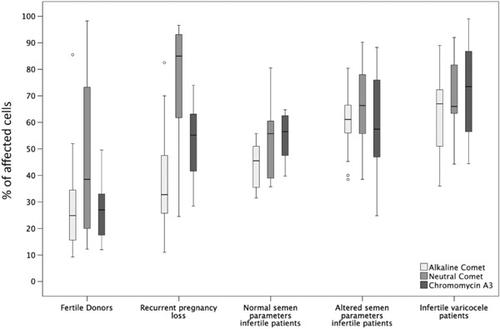当前位置:
X-MOL 学术
›
Mol. Reprod. Dev.
›
论文详情
Our official English website, www.x-mol.net, welcomes your feedback! (Note: you will need to create a separate account there.)
Sperm chromatin condensation and single- and double-stranded DNA damage as important parameters to define male factor related recurrent miscarriage.
Molecular Reproduction and Development ( IF 2.5 ) Pub Date : 2020-09-17 , DOI: 10.1002/mrd.23424 Jordi Ribas-Maynou 1 , Carlos Abad 2 , Sergio García-Segura 1 , Maria Oliver-Bonet 1 , Elena Prada 3 , Maria José Amengual 4 , Joaquima Navarro 1 , Jordi Benet 1
Molecular Reproduction and Development ( IF 2.5 ) Pub Date : 2020-09-17 , DOI: 10.1002/mrd.23424 Jordi Ribas-Maynou 1 , Carlos Abad 2 , Sergio García-Segura 1 , Maria Oliver-Bonet 1 , Elena Prada 3 , Maria José Amengual 4 , Joaquima Navarro 1 , Jordi Benet 1
Affiliation

|
The aim of the present work is to characterize the relationship between sperm protamine deficiency and single‐ and double‐stranded DNA damage and to assess the diagnostic potential of chromomycin A3 (CMA3). For that purpose, semen samples from 90 human males with different clinical features were included (fertile donors, patients with recurrent pregnancy loss [RPL], and infertile patients). DNA condensation was analyzed by CMA3 and different types of DNA fragmentation were analyzed through the comet assay. A positive correlation between DNA condensation and single‐stranded DNA fragmentation was found (Rs = .456; p = .05). CMA3 presented differences between fertile donors and all other groups (p < .001). Interestingly, patients with RPL, who were able to achieve a pregnancy, and infertile patients showed similar values of CMA3 (p > .05). Receiver operating characteristic curves and the profiles obtained by the combination of Comet assays and CMA3 indicate that the CMA3 test may be an interesting approach to distinguish those subjects with higher pregnancy loss risk from fertile donors (CMA3 area under the curve 0.928, with a confidence interval of 0.849–1.000). The present work shows that DNA condensation is related to oxidative damage, which affects mainly protamine‐rich regions. The profiles observed in different clinical groups showed that CMA3 might be useful for the diagnosis of RPL risk when combined with Comet assays.
中文翻译:

精子染色质凝聚和单链和双链 DNA 损伤是定义男性因素相关复发性流产的重要参数。
本工作的目的是表征精子鱼精蛋白缺乏与单链和双链 DNA 损伤之间的关系,并评估色霉素 A3(CMA3)的诊断潜力。为此,包括来自 90 名具有不同临床特征的人类男性的精液样本(可育供体、复发性流产 [RPL] 患者和不育患者)。通过 CMA3 分析 DNA 凝聚,并通过彗星试验分析不同类型的 DNA 断裂。发现 DNA 浓缩和单链 DNA 断裂之间呈正相关(R s = .456;p = .05)。CMA3 显示了可育捐赠者和所有其他组之间的差异 ( p < .001)。有趣的是,能够怀孕的 RPL 患者和不孕患者的 CMA3 值相似 ( p > .05)。接受者操作特征曲线以及通过 Comet 分析和 CMA3 组合获得的曲线表明,CMA3 测试可能是一种有趣的方法来区分那些具有较高流产风险的受试者和可育供体(曲线下的 CMA3 面积为 0.928,具有置信区间) 0.849–1.000)。目前的工作表明 DNA 凝聚与氧化损伤有关,氧化损伤主要影响富含鱼精蛋白的区域。在不同临床组中观察到的特征表明,CMA3 与 Comet 分析相结合可能有助于诊断 RPL 风险。
更新日期:2020-11-25
中文翻译:

精子染色质凝聚和单链和双链 DNA 损伤是定义男性因素相关复发性流产的重要参数。
本工作的目的是表征精子鱼精蛋白缺乏与单链和双链 DNA 损伤之间的关系,并评估色霉素 A3(CMA3)的诊断潜力。为此,包括来自 90 名具有不同临床特征的人类男性的精液样本(可育供体、复发性流产 [RPL] 患者和不育患者)。通过 CMA3 分析 DNA 凝聚,并通过彗星试验分析不同类型的 DNA 断裂。发现 DNA 浓缩和单链 DNA 断裂之间呈正相关(R s = .456;p = .05)。CMA3 显示了可育捐赠者和所有其他组之间的差异 ( p < .001)。有趣的是,能够怀孕的 RPL 患者和不孕患者的 CMA3 值相似 ( p > .05)。接受者操作特征曲线以及通过 Comet 分析和 CMA3 组合获得的曲线表明,CMA3 测试可能是一种有趣的方法来区分那些具有较高流产风险的受试者和可育供体(曲线下的 CMA3 面积为 0.928,具有置信区间) 0.849–1.000)。目前的工作表明 DNA 凝聚与氧化损伤有关,氧化损伤主要影响富含鱼精蛋白的区域。在不同临床组中观察到的特征表明,CMA3 与 Comet 分析相结合可能有助于诊断 RPL 风险。



























 京公网安备 11010802027423号
京公网安备 11010802027423号